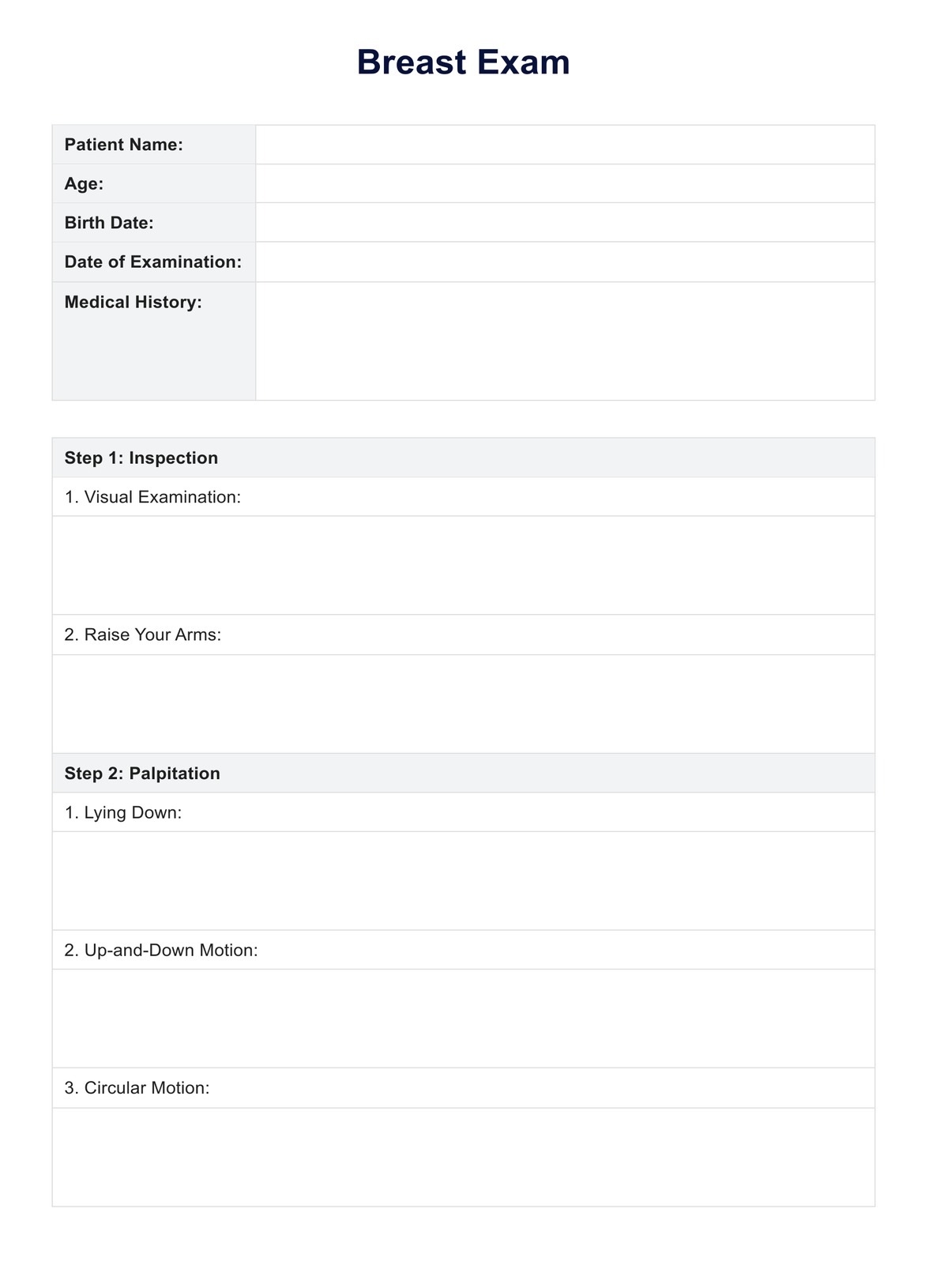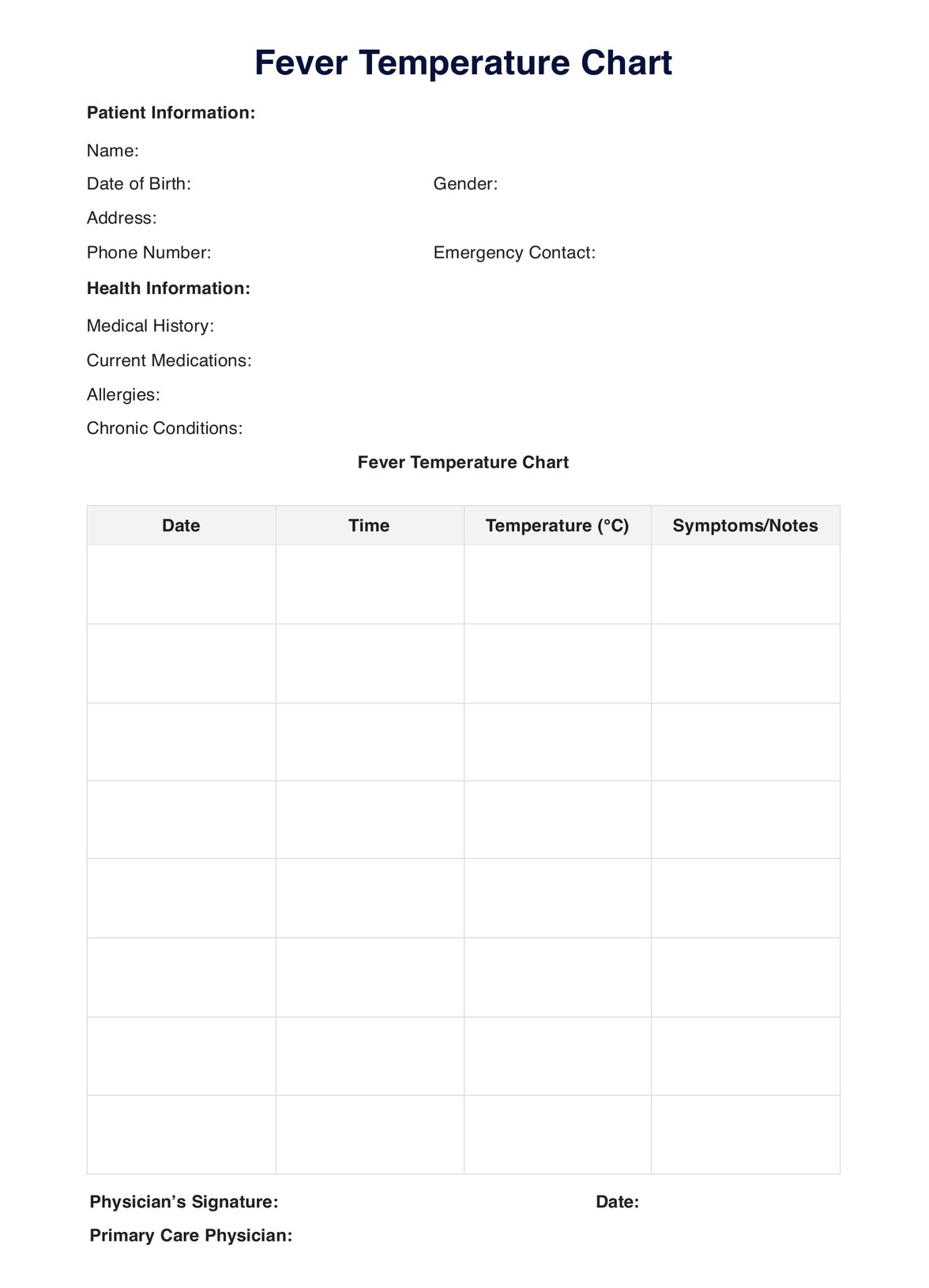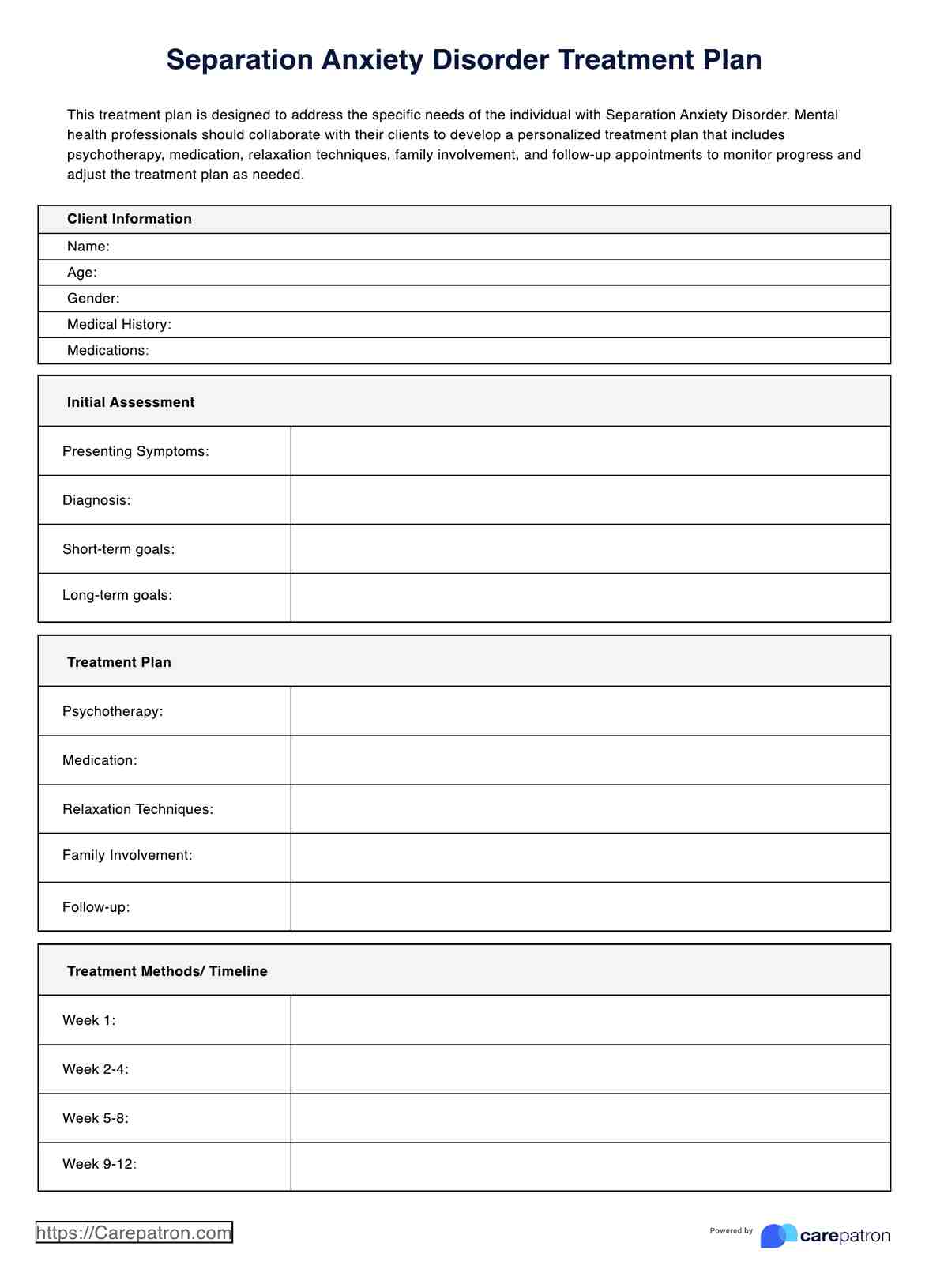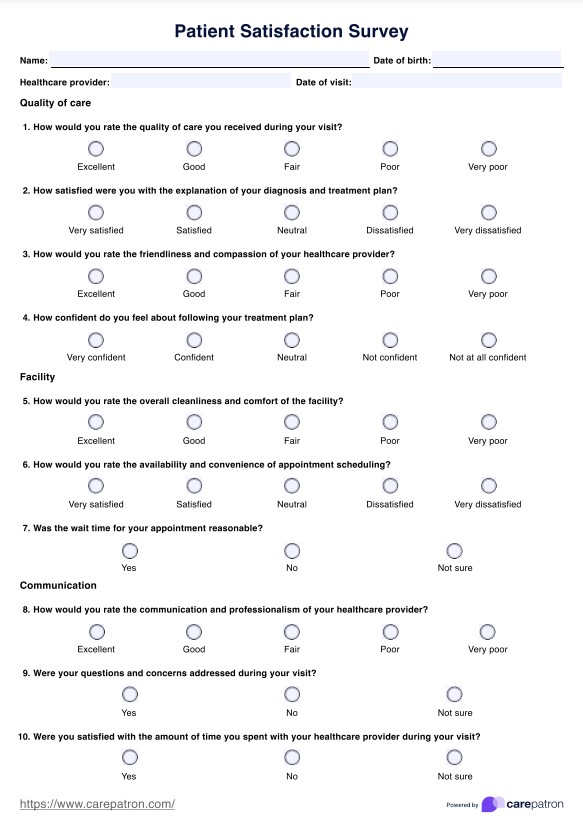Separation Anxiety Test
Use Carepatron's free Separation Anxiety Test PDF to effectively assess separation anxiety symptoms and behaviors in patients.


What is separation anxiety?
Separation anxiety is characterized by excessive fear and extreme distress when an individual is separated from major attachment figures or familiar environments (National Health Service, 2020). While it is commonly observed in early childhood, it can persist into adulthood as adult separation anxiety and significantly impact daily functioning.
Separation anxiety disorder (SAD) is diagnosed when the separation anxiety symptoms are disproportionate to the individual’s developmental stage and cause excessive distress that interferes with social, occupational, or academic life (Feriante et al., 2023). Individuals with SAD often exhibit excessive worry about losing their attachment figures, experience repeated nightmares about separation, and may frequently feel reluctant to be alone or leave home.
Physical symptoms, including headaches, nausea, and stomachaches, are common signs of distress. SAD is often linked to other mental disorders, such as panic disorder and other anxiety disorders. It can develop due to major life changes, and treatment typically involves therapy and coping strategies to manage symptoms.
Separation Anxiety Test Template
Separation Anxiety Test Example
What is the Separation Anxiety Test?
Separation Anxiety Tests are standardized tools used to assess symptoms of separation anxiety in individuals. One of the most widely recognized assessments is the Adult Separation Anxiety Questionnaire (ASA-27), a validated screening tool designed to evaluate adult separation anxiety and its impact on daily functioning.
The ASA-27 has demonstrated strong psychometric properties, including high reliability and validity in diagnosing anxiety disorders (Manicavasagar et al., 2003). It measures a range of anxiety symptoms associated with separation from major attachment figures, including anticipating separation, excessive distress, and avoidance behaviors.
Clinical use of the ASA-27 aids in careful evaluation, differential diagnosis of psychiatric disorders, and treatment planning by clinical psychologists. The test considers various environmental factors, past experiences, and major life events that may contribute to separation-related distress. Results from the assessment help professionals tailor interventions, improve coping skills, and address comorbid conditions such as panic disorder, following standardized diagnostic criteria outlined in the statistical manual.
How does this Separation Anxiety Test work?
Medical professionals can efficiently assess separation anxiety symptoms using Carepatron’s Separation Anxiety Test template. This structured tool streamlines the evaluation process based on the Adult Separation Anxiety Questionnaire (ASA-27). The following steps outline how to access, administer, and interpret the test to support clinical decision-making.
Step 1: Access the test template
Click the "Use template" button to access and edit the template within the Carepatron platform. You can also click "Download" to get a fillable PDF. No manual setup is required—download the template and begin using it for professional assessments.
Step 2: Use the test in patient assessment
The template is designed for structured evaluation, helping clinicians assess separation anxiety symptoms in patients experiencing excessive fear or distress. By incorporating this test into your diagnostic process, you can ensure a careful evaluation of anxiety disorders, attachment-related distress, and associated psychiatric disorders.
Step 3: Conduct the test
Administer the test by guiding the patient through the questionnaire. The structured format ensures a standardized approach to assessing adult separation anxiety and related anxiety symptoms. Encourage honest responses to capture the severity of distress, anticipating separation, and patterns of excessive worry about major attachment figures.
Step 4: Gather and interpret the results
Once completed, calculate the total score to determine the severity of separation anxiety disorder. Higher scores indicate significant distress and potential functional impairment.
Step 5: Discuss results with the patient
Review findings with the patient, explaining how their responses align with clinical markers of separation anxiety disorder. Use a professional yet reassuring approach to validate their experiences and provide insights into how major life events, environmental factors, and attachment figures may contribute to their symptoms.
Step 6: Provide patient education and next steps
Offer guidance on coping skills, treatment planning, and therapeutic interventions. Based on the results, recommend evidence-based strategies such as cognitive-behavioral therapy (CBT), exposure therapy, or pharmacological support if needed. Ensure the patient understands the importance of ongoing care and potential referrals to clinical psychologists for further support.
Scoring and interpretation
The Adult Separation Anxiety Questionnaire is scored based on a raw score ranging from 0 to 81, with higher scores indicating more severe symptoms of adult separation anxiety. The scoring system categorizes severity levels to aid clinical assessment and treatment planning.
- Low or no separation anxiety (0–15): Individuals in this range exhibit minimal symptoms, consistent with typical adult functioning. No significant impact on daily life is expected.
- Some separation anxiety (16–21): This range suggests mild to moderate symptoms of separation anxiety. While the test is highly sensitive and can detect most true cases of adult separation anxiety disorder (ASAD), it may also include false positives.
- Probable adult separation anxiety disorder (≥22): Scores at or above this threshold indicate severe and persistent symptoms of separation anxiety, including excessive worry about harm to attachment figures, avoidance behaviors, and difficulty functioning independently.
Benefits of using this test
The Separation Anxiety Test is a structured self-report measure that allows medical professionals to assess individual symptoms of separation anxiety efficiently. This tool helps identify patients who worry excessively about bad happening to family members, struggle with disruptions to their usual daily routine, or have difficulty when experiencing separation from attachment figures.
The test provides internal consistency, ensuring reliable assessment results that support accurate diagnoses. Using a standardized self-report format, clinicians can quickly evaluate symptoms without requiring lengthy clinical interviews. It also accounts for individual differences, making it a useful tool for screening patients who struggle to sleep away from home, attend school, or function independently for several hours.
Integrating this test into assessments allows healthcare providers to identify patients seeking professional support for mental health concerns. It enhances clinical decision-making by determining whether separation anxiety risks serious harm to a patient's well-being, guiding appropriate interventions.
References
Feriante, J., Bernstein, B., & Torrico, T. (2023). Separation anxiety disorder. StatPearls Publishing. https://www.ncbi.nlm.nih.gov/books/NBK560793/
National Health Service. (2020, December 7). Separation anxiety. https://www.nhs.uk/conditions/baby/babys-development/behaviour/separation-anxiety/
Manicavasagar, V., Silove, D., Wagner, R., & Drobny, J. (2003). A self-report questionnaire for measuring separation anxiety in adulthood. Comprehensive Psychiatry, 44(2), 146–153. https://doi.org/10.1053/comp.2003.50024
Commonly asked questions
Healthcare professionals diagnose separation anxiety using clinical interviews, behavioral assessments, and standardized screening tools like the Separation Anxiety Test (SAT) or the Separation Anxiety Disorder Scale (SADS). They evaluate the severity of distress, interference with daily life, and any physical symptoms triggered by separation from attachment figures.
Common signs of separation anxiety include excessive distress when anticipating or experiencing separation, persistent worry about harm to loved ones, and refusal to be alone. Physical symptoms like headaches, stomachaches, and difficulty sleeping may also accompany emotional distress.
The most effective treatment for separation anxiety involves cognitive-behavioral therapy (CBT) to help individuals manage fears and develop coping strategies. In severe cases, healthcare providers may recommend medication, such as selective serotonin reuptake inhibitors (SSRIs), alongside therapy for comprehensive management.


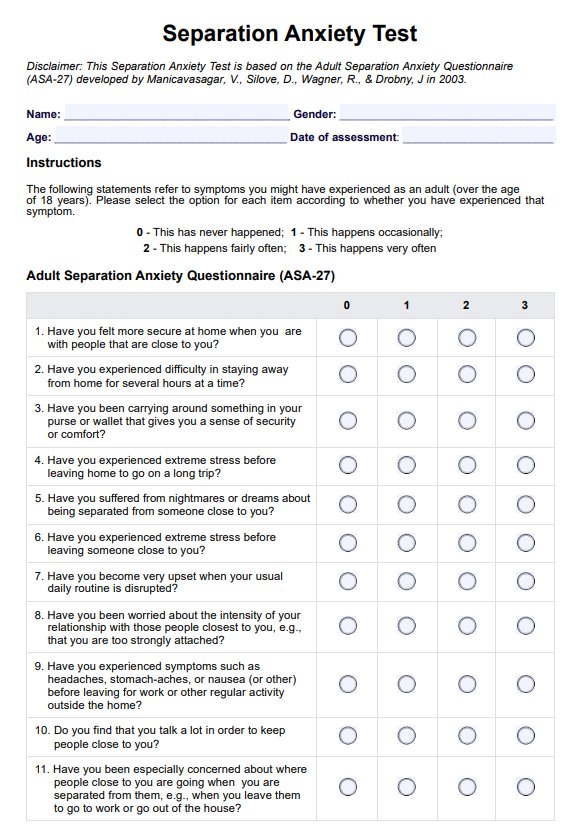
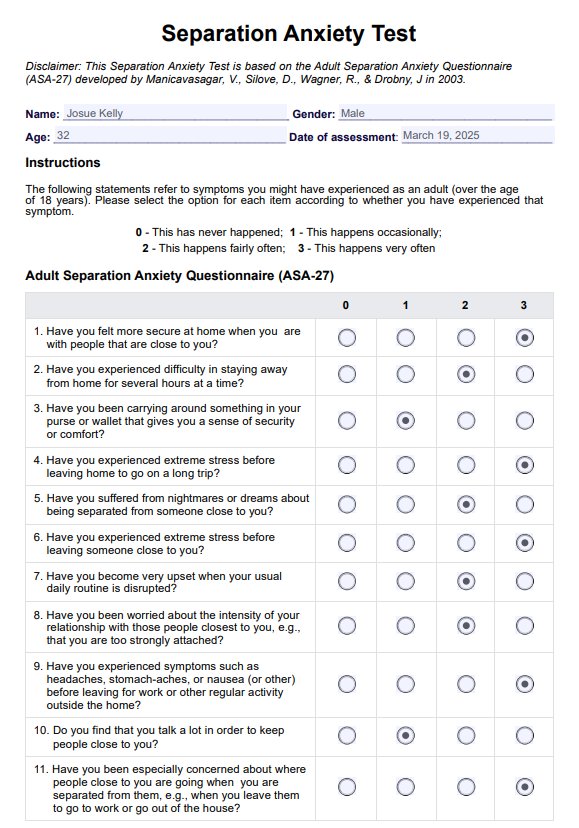

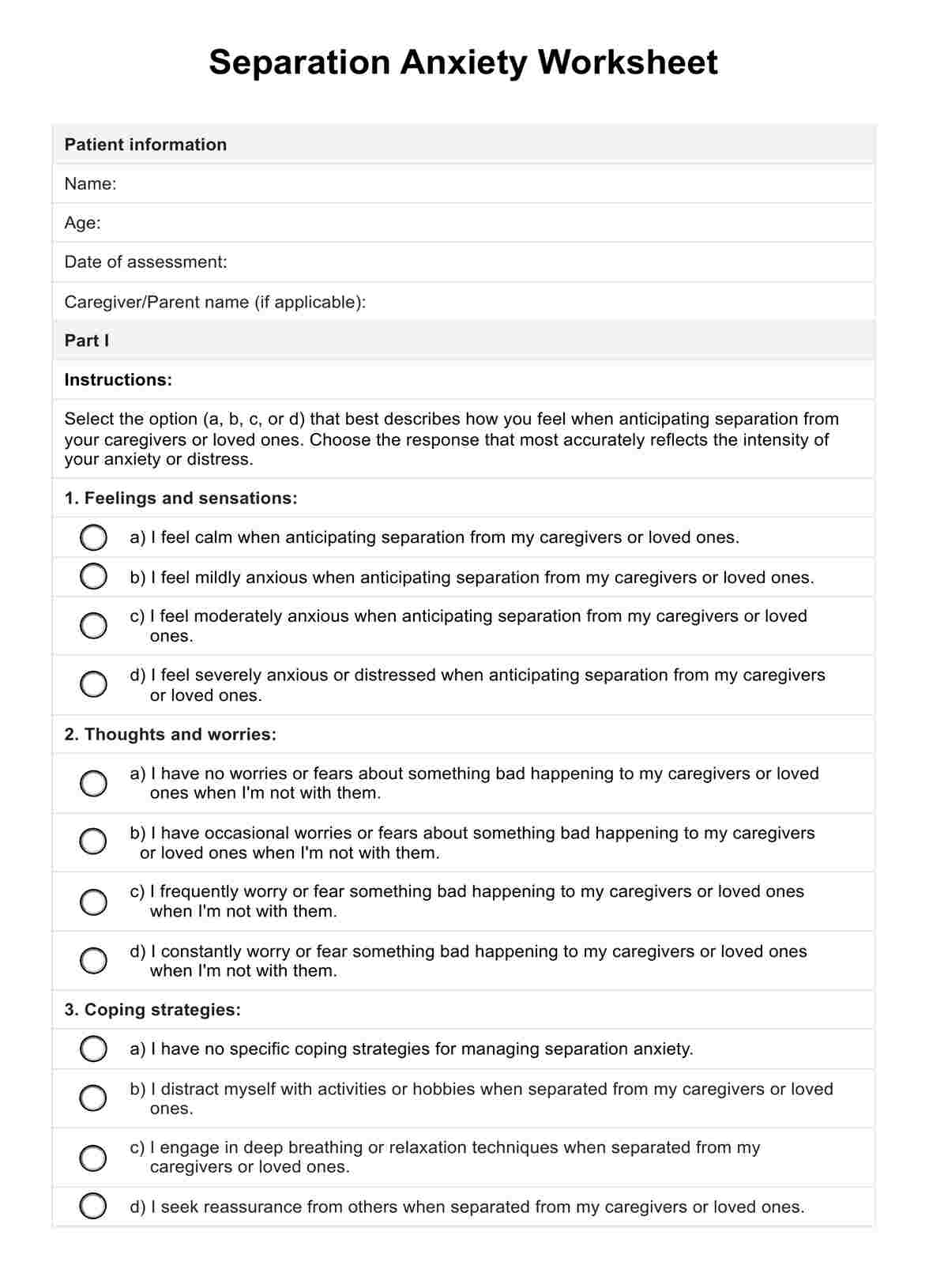

















-template.jpg)
























































































